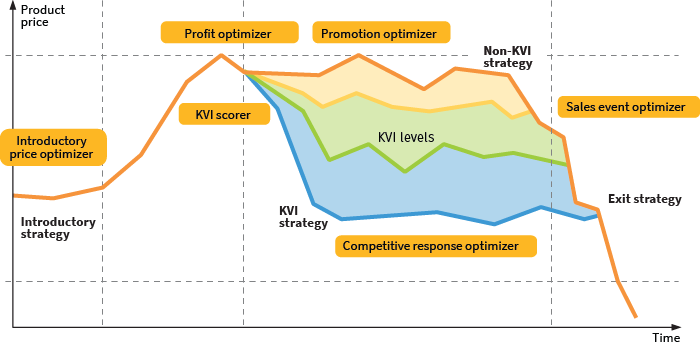
Algorithmic pricing, part II: AI and pricing strategy
AI-based decision automation is particularly beneficial when a large number of decisions must be made in near real time and need to take a wide range of signals into account. Additionally, these decision-making components have to be aligned with the pricing strategy and integrated into the price management process. In this post, we will describe an example of how a pricing strategy can be mapped to intelligent decision-making components.
Strategy example: KVI pricing
In retail pricing, the price strategy is often shaped by two opposing forces: the internal economics of the company, and consumer price perception. Economic considerations, such as revenue and margin targets, are clearly the key drivers and constraints of pricing decisions. At the same time, consumer price perception is also a critically important consideration that is directly linked to company competitiveness, customer loyalty, and sales volume.
One of the most popular techniques for addressing this trade-off between margins and price perception is key value item (KVI) pricing. The basic idea of this approach is to quantify whether a product or product category significantly influences the consumer value perception, and then differentiate the price setting strategy based on this insight. Virtually all retail sectors have some standard items whose prices determine whether a consumer decides a store is expensive or not. These items are referred to as KVIs, with examples including socks and t-shirts in apparel, bananas in grocery, and batteries in electronics. The KVI approach assumes different price setting strategies for KVIs and non-KVIs, and these strategies are typically designed based on the following considerations:
- Price setting for KVIs is done with emphasis on competitiveness and demand. Signals such as competitor price indexes and estimates of the consumer willingness to pay therefore play an important role in KVI pricing decisions.
- Non-KVIs have a smaller influence on value perception, and price setting for these types of products is done with a keener focus on internal economics, that is, margins and category management goals.
In practice, there is no sharp boundary between these two categories, but rather a continuous spectrum of value perception. This spectrum ranges from products with reference prices that are well known to the customer (KVIs), to products for which a customer has some understanding of their reference prices, to products for which a customer has little or no idea about their reference prices (non-KVIs). Consequently, a retailer can have more than two KVI levels, possibly segmented by channels or store zones, or even use a continuous KVI score.
The separation of KVI and non-KVI price setting decisions is only one part of the retail price strategy. The other parts include the introductory price setting, promotion strategy, and clearance sales strategy. Figure 1 illustrates how these parts come together in the context of one particular product lifecycle:
- The introductory pricing approach determines how the price is set for a new product that comes to the market.
- Once the product is launched, a retailer can observe its performance and make a decision regarding whether or not the item should be positioned as a KVI, and then manage its price accordingly.
- Finally, the exit strategy can help to wrap up the life cycle efficiently. This strategy can have a major impact on profitability in sectors with short product life cycles, such as fashion retail.
Decision-making components
The pricing strategy described above requires multiple types of pricing decisions. The quality of these decisions is extremely important, because all of them are directly linked to profitability and customer loyalty. Predictive analytics and advanced automation can help to improve virtually all types of pricing decisions in the KVI strategy example, as each element of the strategy can be mapped to a software component, as shown in Figure 1:
Figure 1. The relationship between decision-making components and pricing strategies.

- Introductory price optimizer. New products do not have a sales history, but their introductory prices can be set more accurately by estimating their similarity to products with sufficient historical data. Similarity scores can be calculated using basic product attributes, as well as textual descriptions and product images that can be utilized using natural language processing and image classification technologies.
- Profit optimizer. Demand, revenue, or profit for a given product depends on many factors, including the store location, season, product price, special offers, stock levels, and competitor prices. Predictive analytics can help to quantify these dependencies and determine the optimal price to maximize revenues or profits.
- KVI scorer. The influence of a given product on consumer value perception can be estimated by an algorithm using product purchasing patterns and the profiles of customers who buy the product. This estimate can then be used to choose the best price setting strategy for the product.
- Promotion optimizer. Price setting for non-KVIs can be performed using profit optimization components. Depending on which strategy is being used, such as the everyday-low-price or high/low approach, specialized optimization components can be created for base prices, markdowns, promotion calendars, and personalized offers.
- Competitive response optimizer. Price setting for KVIs is performed with an emphasis on price perception and generally requires special logic to monitor and respond to competitor price changes.
- Sales event optimizer. Some use cases, such as clearance sales, require specialized logic to perform optimization due to constraints on time and inventory.
Conclusion
This is the second post in a series of articles on the impact of AI on retail price and promotion management. In the first post, we focused on industry trends and the assessment of risks and opportunities in algorithmic pricing. In this post, we zoomed into the relationship between decision automation and pricing strategies in the scope of an individual enterprise. In the final post in the series, we will discuss the technology strategy for all these components.
